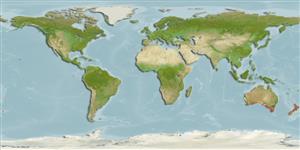>
Scombriformes (Mackerels) >
Arripidae (Australian salmon)
Etymology: Arripis: Latin, arripio, arripere = to take something suddenly.
More on author: Forster.
Environment: milieu / climate zone / depth range / distribution range
Ecologie
marien; brak water; anadroom (Ref. 51243); diepte 30 - 39 m (Ref. 58489). Subtropical; 27°S - 47°S, 112°E - 176°W
Southwest Pacific: southern Australia (including Tasmania, Lord Howe Island and Norfolk Island), usually Brisbane to Western Victoria, rarely to Western Australia; and New Zealand (including Chatham and Kermadec Islands).
Lengte bij maturiteit / Grootte / Gewicht / Leeftijd
Maturity: Lm 32.5, range 29 - 36 cm
Max length : 89.0 cm TL mannelijk / geslacht onbekend; (Ref. 27296); common length : 47.0 cm TL mannelijk / geslacht onbekend; (Ref. 9258); max. gepubliceerd gewicht: 9.4 kg (Ref. 9988); max. gerapporteerde leeftijd: 26 Jaren (Ref. 9072)
Korte beschrijving
Determinatiesleutels | Morfologie | Morfometrie
Dorsale stekels (totaal) : 9; Dorsale zachte stralen (totaal) : 15 - 17; Anale stekels: 3; Anale zachte stralen: 9 - 10; Wervels: 25. Adults are dark blue-green above and silvery below, with irregularly defined spots arranged laterally in indistinct rows (Ref. 33616). Length of upper lobe of caudal fin < 29.9% SL, more or less equal to, or less than, the length fo the head (Ref. 9701).
Inhabit continental shelf waters including estuaries, bays and inlets (Ref. 6390). Found between depths of 30 m (Ref. 33616) and 39 m (Ref. 58489). They enter rivers (Ref. 9002). Juveniles form school in shallow coastal bays and estuaries; adults move in large schools along shores (Ref. 9002), and can move over reefs in depths just sufficient to cover their bodies (Ref. 6390). They form large surface aggregations in deep water (Ref. 6390). Feed mainly on fishes but also on pelagic crustaceans, especially krill (Nyctiphanes australis). Take also food from the seabed. Fish smaller than 10 cm feed predominantly on copepods (Ref. 9072). Utilized fresh, canned and frozen; can be steamed, fried, broiled, boiled, microwaved and baked (Ref. 9988).
Eastern Australian salmon are probably serial batch spawners (Ref. 27961).
Paulin, C., 1993. Review of the Australian fish Family Arripididae (Percomorpha), with the description of a new species. Aust. J. Mar. Freshwat. Res. 44(3):459-471. (Ref. 9701)
Status op de Rode Lijst van het IUCN (Ref. 130435)
Gevaar voor de mens
Harmless
Gebruik door de mens
Visserij: commercieel; sportvis: ja; aas: usually
Tools
Speciale rapporten
Download XML
Internetbronnen
Estimates based on models
Preferred temperature (Ref.
123201): 15.6 - 22.3, mean 17.4 °C (based on 14 cells).
Fylogenetische diversiteitsindex (Ref.
82804): PD
50 = 0.6250 [Uniqueness, from 0.5 = low to 2.0 = high].
Bayesian length-weight: a=0.00955 (0.00352 - 0.02589), b=3.01 (2.79 - 3.23), in cm total length, based on LWR estimates for this (Sub)family-body shape (Ref.
93245).
Trofisch niveau (Ref.
69278): 4.1 ±0.6 se; based on diet studies.
Generation time: 4.1 (3.3 - 7.9) years. Estimated as median ln(3)/K based on 11
growth studies.
Weerstandsvermogen (Ref.
120179): Gemiddeld, minimale populatieverdubbelingstijd 1,4-4,4 jaar (K=0.2-0.3; tm=4).
Prior r = 0.39, 95% CL = 0.26 - 0.59, Based on 2 full stock assessments.
Fishing Vulnerability (Ref.
59153): Moderate vulnerability (37 of 100).
Climate Vulnerability (Ref.
125649): Very high vulnerability (100 of 100).
Nutrients (Ref.
124155): Calcium = 52.1 [34.3, 88.4] mg/100g; Iron = 1.2 [0.8, 1.8] mg/100g; Protein = 20.7 [18.4, 22.6] %; Omega3 = 0.365 [0.227, 0.591] g/100g; Selenium = 19.2 [11.0, 32.9] μg/100g; VitaminA = 13.8 [5.4, 36.4] μg/100g; Zinc = 0.672 [0.506, 0.912] mg/100g (wet weight); based on
nutrient studies.
